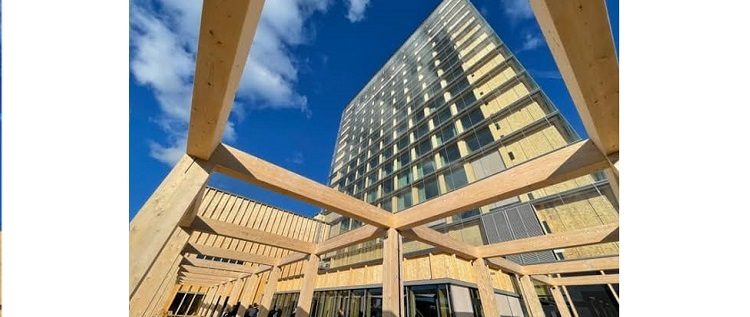E - PAPER
Sweden’s Eco-Town of Wood with 20-Storey Wooden Skyscraper
As you come in to land at Skellefteå airport in the far north of Sweden, you are greeted by a wooden air traffic control tower poking up from an endless forest of pine and spruce. After boarding a biogas bus into town, you glide past wooden apartment blocks and wooden schools, cross a wooden road br
 BY
Realty Plus
BY
Realty Plus
Published - Sunday, 17 Oct, 2021

As you come in to land at Skellefteå airport in the far north of Sweden, you are greeted by a wooden air traffic control tower poking up from an endless forest of pine and spruce. After boarding a biogas bus into town, you glide past wooden apartment blocks and wooden schools, cross a wooden road bridge and pass a wooden multistorey car park, before finally reaching the centre, now home to one of the tallest new wooden buildings in the world.
Small subarctic Skellefteå (pronounced similarly to “she left you”) has Europe’s largest battery factory is currently under construction. The next generation of electric vehicle batteries will not only be produced here, but recycled too. Electric helicopters will soon be able to shuttle visitors to the gargantuan Northvolt gigafactory, while longer-distance electric aeroplanes are being tested nearby.
Skellefteå runs on 100% renewable energy from hydropower and wind, and recycles 120,000 tonnes of electronic waste a year, with excess heat from the process fed back into the city-wide heating system. And now, nosing 20 storeys above the low-rise skyline, Skellefteå has a fitting monument to its carbon-cutting credentials. The Sara Cultural Centre and its towering Wood Hotel stand as beacons of what it is possible to do with timber – and store about 9,000 tonnes of carbon from the atmosphere in the process.
The technology behind it is surprisingly simple. The two main materials are glued laminated timber (glulam) and cross-laminated timber (CLT). The former is made from layers of lumber bonded together, with the grain running in the same direction, giving it a higher load-bearing capacity than both steel and concrete, relative to its weight. It is ideal for columns and beams, and forms the structural bones of the cultural centre, which is home to two theatres, a museum, an art gallery and a library.
The “self-finish” nature of structural mass timber, which can simply be left exposed, means that the tower was incredibly quick to build, doing away with the usual wet trades of plastering and decorating. A whole year was saved by using wood, compared with steel and concrete, with a storey completed every two days. The number of truck deliveries was also reduced by about 90%, with practically zero waste on site. Like bits of a giant balsa-wood model, the pieces came from factories ready to be bolted together, some in panels 27 metres long, while the trees were harvested from within a 60km radius of the site – and have all since been replenished. Just like the region’s forest-foraged restaurant menus, this is meaningful local sourcing rather than a green veneer.
With all these exposed timber walls, ceilings and floors, the place feels like a gigantic sauna – with the aroma to match. But look closely and you’ll see it’s not all wood. Big steel plates are bolted through the giant plywood walls on the fifth floor, revealing the presence of a big steel truss – used to transfer the weight of the tower to the walls of the cultural centre, making it possible to have a column-free space below. Concrete is also used on the top two floors, to stop the tower from swaying too much in the wind.
In keeping with the city’s advanced (and municipally owned) energy network, the building uses artificial intelligence to monitor energy use and predict heating needs, as well as communicate with surrounding buildings. Excess energy produced by the building’s solar panels can be sent to the nearby travel centre, for example, or saved in batteries in the basement. If the cultural centre needs more heat, the surplus from a neighbouring building being cooled can be transferred over.
This wooden wonder might seem like a novelty one-off, a trophy to showcase the local timber industry, only feasible because of the location. But the architects are keen to emphasise that the same process could be replicated anywhere, many hundreds of miles from a forest.
RELATED STORY VIEW MORE
TOP STORY VIEW MORE

Mixed Outlook for Australia's Housing Sector In 2024
Mixed Outlook for Australia's Housing Sector In 2024
05 December, 2024NEWS LETTER
Subscribe for our news letter
E - PAPER
-

CURRENT MONTH 
LAST MONTH














